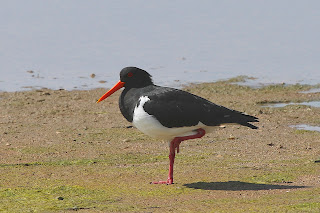I have been to Werribee 21 times this year, so far, but this
is the first time I have ever been down there 3 times in one week. There was no
particular plan, it just happened that way. Tuesday 25th was a nice
day to go birding, and on Thursday 27th Marlene thought it would be a good place
to go, and I agreed. On the 30th Kay came over from Adelaide to see
the Oriental Pratincole that has been in residence for some time, so that was
another good reason to visit. Thinking about it, there is always a good reason
for a day at the Plant.
On Tuesday the weather was beautiful and spring was really in the air. The swans have young swanlets following everywhere and the Fairywrens have all their flirt feathers on.
 |
| Two of the many "swanlets" at the plan. |
 |
| Superb Fairy-wren with all his flirt feathers on |
The Red-necked Stints are back and feeding like crazy after their long flight but their feathers are all badly warn. There are some strange plumage colours around this year too with very pale stints and some sharpies that had me diving wishfully for the field guide.
 |
| Red-necked Stint with very warn feathers after a long hard trip |
 |
| Curlew Sandpiper with strange plumage |
On Thursday I got out of bed and wondered why I had agreed
to go to the Plant again, in the wind and rain, but soon after we arrived the
wind died down and the blue sky appeared to give us a beautiful day of birding.
 |
| Blue-winged Parrots with very blue wings |
 |
| Brown Songlark |
 |
| Brown Songlark |
 |
| Eurasian Skylark |
 |
| Pied Oyster-catcher |
 |
| Bar-tailed Godwit |
 |
| A shadow passed over me and I looked up in time to see this beautiful Spotted Harrier flying passed and away |
On Sunday I wondered again why I had agreed to go to the
Plant. Saturday had been bleak with driving rain and squalls. But as I drove to
pick up Joy and then meet Kay the day improved by the minute and by the time we
got to the Plant we had a bright sunny day, if somewhat cold. Kay had come over
from Adelaide especially to see the Oriental Pratincole and sort of lucked out.
I had seen it on Tuesday but not on Thursday, and now the day was cold and
windy so I expected it to be hunkered down behind a bush somewhere, out of
sight. As we got out of the car to unlock the gate into the Western Lagoon we
looked up, and the Pratincole flew over our heads and disappeared, not to be
seen again. Sigh. But at least she saw it, which is more than some people have
done in the last few weeks.
 |
| Banded Lapwing on nest |
 |
| Red-browed Firetail |
 |
| European Goldfinch |
 |
| "Chook" or Black-tailed Native-hen |
 |
| Masked Lapwing with chick. She is sitting on two more eggs |
 |
| Zebra Duck, part of a tight flock of 4,000 to 5,000 birds. A truly spectacular sight |
 |
| Well, they used to be called Zebra Duck before they became Pink-eared Duck |
 |
| When a bird lands on a sign right beside the car, you just have to take its photo |
 |
| Duckling trying to emulate its mother, as instructed |
 |
| Female Black Duck sinking ever lower in the water, trying not to be there at all |
 |
| Ruddy Turnstone well camouflaged in seaweed as it digs around looking for food |
 |
| Juvenile Banded Stilts on Paradise Rd lagoon |
To add to the excitement at the Plant at the moment though is that the Tiger Snakes are out and about, and not always happy.
Allimages copyright Jenny Spry



















































